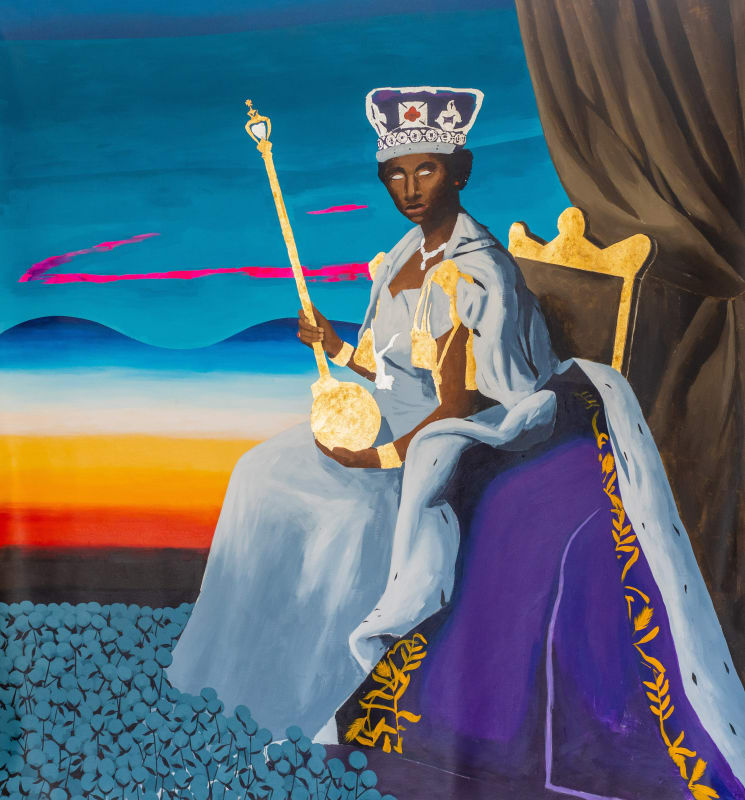Boluwatife Oyediran borrows the codes of ethnocentric occidental art to preach in favour of a better representation of black persons and questions the conception of power and norms. He replaces the usual heroes of religious and political imagery with those who have been historically discarded or made invisible from the spheres of power.
Historical personalities and emblematic scenes of religious paintings enrich the pictorial vocabulary of Boluwatife Oyediran. In his solo exhibition Point of Correction, the Nigerian painter writes an alternative story, changing the complexion of widely known historical figures. He corrects the very notions of black identity, power, fashion and monarchy, whilst anchoring his compositions in the history of cotton-growing. He highlights that power patterns are not immutable. Through strong images challenging the representation of traditional icons, he establishes new models and conveys hope. Far from a fatalistic view, he suggests new possible paths and claims that every voice counts.
Boluwatife Oyediran borrows the codes of ethnocentric occidental art to preach in favour of a better representation of black persons and questions the conception of power and norms. He replaces the usual heroes of religious and political imagery with those who have been historically discarded or made invisible from the spheres of power. While the Diaspora series by Senegalese photographer Omar Victor Diop highlights African personalities, who played an important role outside the continent and of whom History forgot the names, Boluwatife Oyediran changes the skin colour of major figures in European History. From Queen Elizabeth II to Pope John Paul II and Napoleon, who he embodies in a self-portrait, he shakes up the historical representation of power and racial hierarchy. Symbolically, by adopting the features and posture of the man who seized power during the Coup of 18 Brumaire (9 November 1799), he takes the power back.
If he changes the white skin colour of historical persons, he denounces the imagery and the Christian ideology in the vein of Harmonia Rosales. The Afro-Cuban American artist takes Michelangelo’s masterpiece The Creation of Adam to denounce patriarchal and white art and represents black women instead of the original characters. Oyediran takes over another emblematic artwork from Christian iconography: The Last Supper. While the composition is identical to Philippe de Champaigne’s work nicknamed ‘The Little Last Supper’ (1648), itself inspired by Leonardo da Vinci’s The Last Supper (1495-1498), Oyediran operates a twist in the depiction of the skin. He represents Jesus as a black man crowned with a golden halo. A central figure, both the gazes of the apostles and the viewers lead toward him. The attraction is as strong as sharp, with a contrast emerging with the men surrounding him. Their skin melts in a colourful mix, erasing their identity. Furthermore, Oyediran inspires new icons by adorning his characters with a halo. In this way, he aims to question the European interpretation of the Bible, the games of power, as well as the hierarchy within religion.
Creating portraits easily identifiable and reinterpreting evocative paintings whose original codes have been shifted, Oyediran invokes a familiar aesthetic and appeals to common imagination. He calls for the inclusion of black persons who have been historically marginalised, exploited, excluded and under-represented, by reversing this under-representation and giving them back their share of power. He reverses stereotypes and instills new values. Even if subversive, his work is above all optimistic. Oyediran does not sink into an accusative speech. On the contrary, he speaks up for a better future without reproducing past mistakes. He proposes to rethink the pre-existing hierarchy and the patterns of power by bringing historical correction. The artist explains “I met someone who once told me that my figures appear to be phoenixes rising out of their own ashes (the cotton fields), in glory and splendour. I quite agree with that.”
If he imitates the codes of classic painting from Leonardo da Vinci to Rubens, Oyediran quotes the surrealist movement as the main source of his inspiration. Born between the two world wars, Surrealism opposed the rigour imposed during the Renaissance and invited viewers to free their unconscious by pushing back any rational barriers. The cotton fields in the background of Oyediran’s canvases thus recall a collective unconscious history. While the central solitary figure seems lost in the immensity and infinity of their environment, the work reveals the weight of history on the construction of one’s identity.
Boluwatife Oyediran notes the similarities between the history of fashion and cotton-growing through the role played by black persons. The cotton fields refer to the Transatlantic Slave Trade that participated in the prosperity and lushness of the colonial Empire, as well as the industrial revolution. His characters, in flamboyant clothing, who are immersed into these cotton fields silently evoke the history behind cotton-growing. In this way, he puts forward these hidden figures who were fundamental to the economic success. He frees them from the weight of the past and empowers them.
Ultimately, Boluwatife Oyediran does not rewrite History, but invites viewers to reflect on it. It is not about forgetting the past but rather about building the future. If Point of Correction showcases historical figures, the exhibition talks above all about representation. It affirms that every person’s speech matters and that everyone can achieve their dreams regardless of the colour of their skin. Oyediran seeks to inspire and encourage new generations by erecting new models to prove anything is possible.

